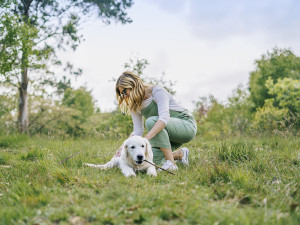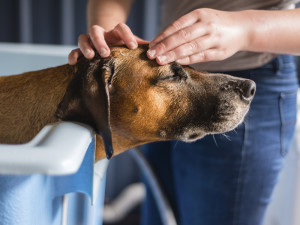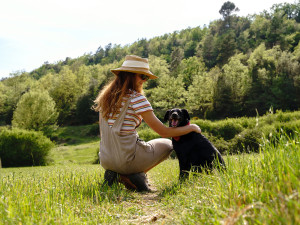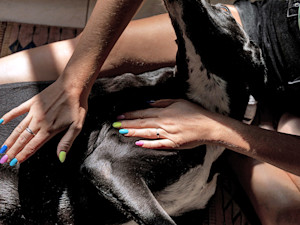What to Do If You Find a Tick on Your Dog
It might give you the ick, but you need to take action
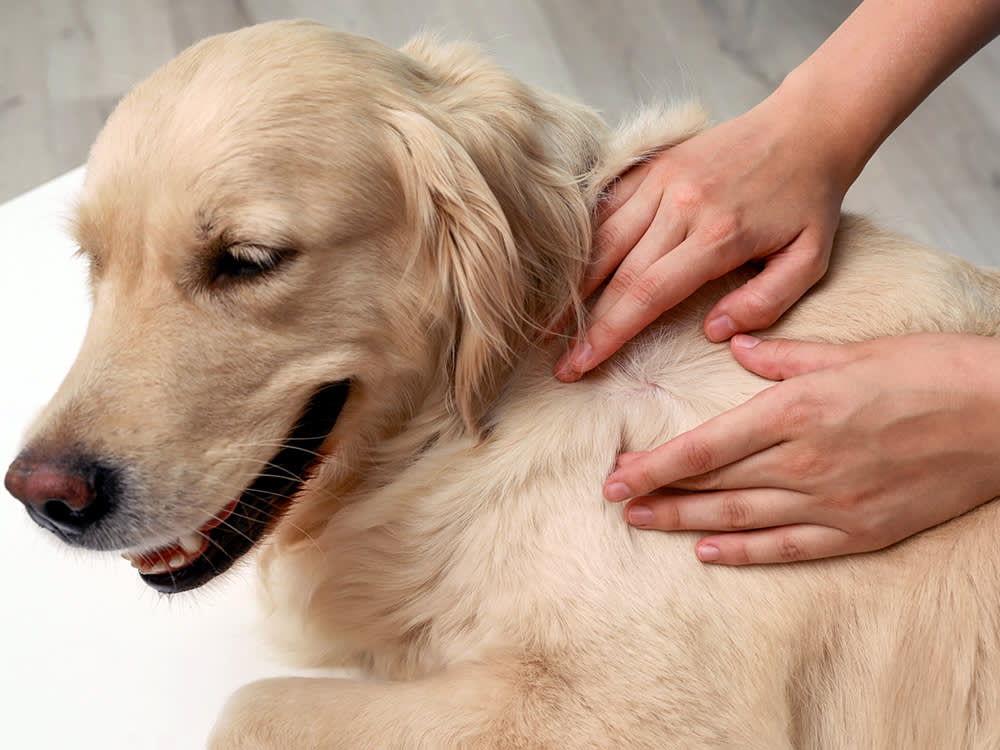
Share Article
If thoughts of creepy crawlies are too much for you to bear then it‘s time to make friends with someone less squeamish. External parasites love your dog and it’s up to you to protect them from these teeny weeny predators. Some, like fleas, can (usually) be treated at arm’s length, but others – like ticks – involve getting a little more up close and personal.
If you find a tick on your dog in the UK however, don’t panic, we’re here to help. In this article, we’ll discuss what ticks are, how to check your dog for them, how to remove them, how to prevent them in the first place, and find out what risks they pose.
Main takeaways
Ticks are relatively harmless and, once you have been shown the technique, they are relatively easy to remove.
Ticks can transmit a few different diseases in the UK, and many more if a tick is picked up abroad. To transmit a disease a tick must be infected and also attach for over 24 hours. These conditions will require prompt veterinary treatment.
Tick prevention and regular checks of your pet are the best way to protect your dog from tick-borne disease.
What are ticks?
Ticks are tiny spider-like creatures that can be found anywhere outside in the UK. However, they live in large numbers in forests and on heaths. Ticks cannot fly or jump but instead attach to the skin of humans or animals that brush past them. They feed on blood for a few days before dropping off. They can carry diseases, which they transmit to animals while attached to their skin. Delightful.
How do I know if my dog has a tick?
A tick initially feels like a small scab and looks like a tiny brown mole (the skin kind, not the cute woodland creature kind) on your dog’s skin. As the tick feeds on your pet’s blood, it will grow in size until it is more clearly visible. It will develop a greyish-blue colour due to the ingested blood. You will be able to see the tick’s tiny legs, and the body of the tick has a dimple in the back.
Checking your dog
You should check your dog for ticks regularly – especially in the warmer months. To check your dog, you should systematically feel their skin all over, paying close attention to the inside of the ear flap, around the eyes, in the groin and beneath the elbow. However, ticks are clever little pests and can attach anywhere on the body.
If you find one, there may be more, so be sure to keep on checking until you’ve done a thorough search of your pup. If you find any lumps or bumps, part the hair so that you can examine the skin closely; this is where ticks latch on. Pet parents to hairier canines may have to look a little harder.
What to do if you find a tick
If you find a tick, don’t panic and start trying to pick it out. Instead, familiarise yourself with a safe method of removal before attempting to take the tick off your pet. If you still don’t feel comfortable, ask your vet to show you. Getting it wrong can end up with the mouthparts of the tick being left in the skin, which can cause a local reaction and, in some cases, require minor surgery to remove them. Ensure your pet is treated with tick prevention to stop any further ticks from latching on.
Types of ticks in the UK
There are several tick species native to the UKopens in new tab that are relevant to dogs. These include members of the Ixodes family, such as the castor bean tick, the Hedgehog tick (not as cute as it sounds) and the Dog tick. Other native species include Dermacentor reticulatus, the Ornate dog tick and Haemaphysalis punctata, the red sheep tick.
As pet travel to Europe becomes more common, we are seeing an increase in non-native species, such as the brown dog tick (Rhipicephalus sanguineus). These exotic species are also bringing diseases that were previously not reported in the UK.
How to remove a tick
• Ensure it is a tick. Sometimes small growths can closely resemble ticks, and you may hurt your pet in attempting to remove one. If you are not sure, check with your vet.
• If your pet has long fur, it can be helpful to gently trim around the tick to help you see it. However, it’s very important not to cut the tick, as this will leave the mouthparts embedded in your pet. In most cases, parting the fur works well.
• If using a tick remover, position the hook beneath the tick, where it is embedded in the skin.
• Ensure the hook is securely in place.
• Gently twist. Do not pull.
• Continue to do this until the tick comes away. Examine the tick to ensure that the mouthparts have come away with the rest of the body and aren’t still embedded in your dog.
• Place the tick in a sealed container and dispose of it.
• Monitor the area for any redness or swelling and inform your vet if you are concerned.
Protecting your dog from ticks
There are several methods to protect your pet from ticks. The first is to check your dog after walking in areas where ticks are commonly found, such as wooded or grassy areas, and remove any ticks promptly.
If ticks are a common problem in areas you regularly visit with your dog, it is advisable to get some tick prevention medication. These come in the form of tablets, spot-on solutions and collars. It is best to purchase these from your vet, who can dispense strong, safe and effective medication for your dog. The medications need to be repeated, or in the case of collars, replaced, at specific time intervals depending on the product. The medication doesn’t prevent the tick from attaching to the skin but kills it rapidly after attachment.
Risks of ticks on dogs
Ticks can cause a local inflammatory reaction, which usually resolves a few days after the tick is removed. If the tick is removed incorrectly, leaving part of the tick behind, it can cause a foreign body reaction. Veterinary intervention to remove the mouthparts is often required.
In some cases, ticks can transmit diseases. For this to happen, the tick needs to be carrying a disease, and only a small proportion of UK ticks are infected. However, this number is increasing. The tick also needs to attach to your dog for over 24 hours.
In the UK, the most common disease transmitted by ticks to dogs is Lyme disease. This is a bacterial infection that can also infect humans (but is not directly transmitted from dog to human). In dogs, it causes lameness that moves from leg to leg, a low-grade fever, swollen lymph nodes, and loss of appetite. Symptoms don’t usually appear until a few months after infection and require a lengthy course of antibiotics to treat. In rare cases, Lyme disease can result in kidney disease, which can be fatal.
Anaplasmosis is another disease transmitted by ticks. It also results in fever and loss of appetite but tends to respond to treatment more quickly than Lyme disease. Some dogs may become infected with multiple diseases after tick exposure.
As more dogs travel abroad and our climate gets warmer, we are seeing new tick species becoming established in the UK, bringing new tick-borne diseases. One such disease is Babesiosis, which destroys red blood cells, leading to severe anaemia. Your dog may have pale gums, become weak and wobbly, and develop a yellow tinge to their skin, gums and eyes (jaundice). Treatment exists; however, in some cases, animals with severe symptoms may die despite treatment.
If your dog regularly travels abroad, it is even more important to use tick prevention and be aware of the tick-borne diseases that they might be at risk of. In the UK, we are relatively sheltered from some of the more exotic and dangerous tick diseases.
Ticks on dogs: frequently asked questions
Should I be worried if I found a tick on my dog?
Ticks are usually harmless and cause nothing more than mild inflammation and irritation. However, if they remain on your dog for over 24 hours, they could transmit disease. For this reason, it is important to use tick prevention treatment and check your pet regularly for ticks, especially if they have been walking through forests or grassland where ticks live in abundance.
Will a dog be OK after a tick bite?
The tick itself will, at most, cause inflammation. If removed incorrectly, your pet may have a reaction to the part of the tick that is left behind, which may need to be surgically removed. Some ticks will transmit diseases if allowed to remain in place for over 24 hours. While treatable, some of these conditions can result in severe symptoms that could be fatal.
Should I take my dog to the vet for a tick?
Ticks are relatively easy to remove and don’t usually require veterinary intervention. However, if you are not confident, your vet practice can show you how to remove the tick. If the tick has been in place for some time (over 24 hours), it may be worth discussing with your vet how to test for tick-borne diseases.
What kills ticks on dogs instantly in the UK?
If a tick is still attached to your pet, it is best to remove it first before killing it, as this can make the mouthparts harder to remove. Once the tick is off your dog, you can submerge it in spirit to kill it.
References
Royal Veterinary College, Vet Compass. Tick Parasite Infestation in UK Dogsopens in new tab. Accessed 9 Jan. 2025.
Preventing Tick-Borne Diseaseopens in new tab | Research | University of Bristol. Accessed 9 Jan. 2025.
“Tick IDopens in new tab.” ESCCAP UK & Ireland, Blue Fusion Web CMS. Accessed 9 Jan. 2025.

Dr Nina Blackmore, MRCVS, BVSc, PgCertSAECC
Nina Blackmore is a vet who, after leaving the Royal Army Veterinary Corps, took up two very different lives. For four long, chaotic days each fortnight she lives in a tiny house next to a small animal veterinary hospital in Boston, managing hospitalised patients and treating any emergency cases that turn up. As well as emergencies she also has a keen interest in pain management and acupuncture. The rest of her time is spent in a quirky bungalow in Rutland where she and her husband run a self sufficient small holding and a dog home boarding business. She spends her life surrounded by animals and has made it her life goal to help as many as possible.
Related articles
![A woman in beige overalls a striped shirt and a straw hat, smiling, with her arm around her black dog sitting in the grass on a green hill.]()
The Best Flea and Tick Preventatives and Treatments For Dogs
Because an infestation is the last thing your pup – and your home – needs
![puppy scratching fleas, get rid of fleas on dogs]()
Home Remedies for Getting Rid of Fleas on Dogs – Naturally
How to stop your home from becoming a flea circus
![hands with different coloured nails stroke a black greyhound]()
What’s This Weird Lump Of Skin On My Dog?
Understand the causes, identification, treatment options and when to seek veterinary advice for skin tags on your dog
![Woman holding a beagle in warm dappled summer light]()
You’ve Got a Summer-Lovin’ Pup. Here’s How to Keep Them Safe
Some like it hot (but not most dogs). Here are the season’s health hazards, from fleas to grass seeds

